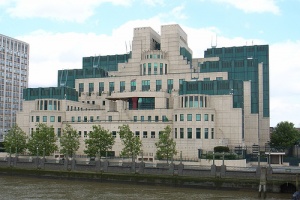Difference between revisions of "Secret Intelligence Service"
| Line 1: | Line 1: | ||
| − | [[Image:MI6HQ.jpg|right|thumb|300px|SIS Headquarters on the bank of the Thames almost across from Parliament<br | + | [[Image:MI6HQ.jpg|right|thumb|300px|SIS Headquarters on the bank of the Thames almost across from Parliament<br><i>Photo: Steve Cadman</i>]] |
More commonly known as [[MI6]], Britain's foreign intelligence service. | More commonly known as [[MI6]], Britain's foreign intelligence service. | ||
Revision as of 08:05, 8 September 2009
More commonly known as MI6, Britain's foreign intelligence service.
Contents
People
Chiefs of the SIS
- Mansfield Cumming - 1909-1923
- Rear Admiral Hugh Sinclair - 1923-1939
- Major-General Sir Stewart Menzies - 1939-1952
- Major-General Sir John Sinclair - 1952-1956
- Sir Dick White - 1956-1968
- Sir John Rennie - 1968-1973
- Sir Maurice Oldfield - 1973-1978
- Sir Arthur Temple Franks - 1978-1981[1]
- Sir Colin Figures - 1981-1984[2]
- Sir Christopher Curwen - 1985-1988
- Sir Colin McColl - 1988-1994
- Sir David Spedding - 1994-1999[3]
- Sir Richard Dearlove - 1999-2004[4]
- Sir John Scarlett - 2004-[5]
Sir John Sawers is due to take over as head of MI6 in November 2009.[6]
Notable officers
Structure
Michael's Smith's 2003 book The Spying Game describes the following MI6 structure:
- Chief of the Secret Service
- Secretariat: attached to C's office, in charge of liason with FCO, MoD, other intelligence agencies.
- Assistant Chief
- Directorate of Regional Affairs
- Middle East and Africa Controllerate
- Eastern and Central Europe Controllerate
- Western Hemisphere and the Far East Controllerate
- Western Europe Controllerate
- Directorate of Personnel, Training and Finance
- Directorate of Security and Public Affairs
- Directorate of Information Technology
- Directorate of Global Issues
- Counter Terrorism Section
- Counter Proliferation Section
- Counter Narcotics Section[7]
I/Ops (Information Operations)
Psychological warfare section of SIS.
- In early 1998, when British and American forces were preparing to attack Iraq if Saddam did not fulfil pledges on UN inspection of presidential sites, MI6 received or invented intelligence that there were Iraqi plans to smuggle Anthrax into Britain in bottles of duty free perfume and spirits. A CX report to that effect was passed to the JIC. It was nonsense but fitted into a pattern of disinformation. [8]
According to former SIS agent Richard Tomlinson, paid agents in the 1990s included one and perhaps two national newspaper editors. [9]
- In his controversial book being published in Russia, Tomlinson, according to book excerpts leaked to the Moscow press, said that in the early 1990s the editor of the Spectator was on MI6's books and provided cover for an agent named as Spencer who was put on the case of a young Russian diplomat, Platon Obukhov, in Tallin, the capital of Estonia.
- Tomlinson writes that Mr Lawson's MI6 identity was "Smallbrow". Mr Lawson was the editor of the Spectator from 1990-95 before moving to its sister publication, the Sunday Telegraph.
- Mr Lawson yesterday strongly denied both allegations. [10]
Notes
- ↑ MI6: Inside the Covert World of Her Majesty's Secret Intelligence Service, by Stephen Dorril, Touchstone, 2002
- ↑ Obituary - Sir Colin Figures, by Dan Van Der Vat, Guardian, 18 December 2006.
- ↑ MI6: Inside the Covert World of Her Majesty's Secret Intelligence Service, by Stephen Dorril, Touchstone, 2002
- ↑ New MI6 spymaster named, BBC News, 25 February 1999, accessed 26 February 2008.
- ↑ The British Secet Intelligence Service - (SIS)- who we are, accessed 26 7 May 2009.
- ↑ Richard Norton-Taylor, Sir John Sawers named as new chief of MI6, guardian.co.uk, 16 June 2009.
- ↑ Michael Smith, The Spying Game, Politico's Publishing, 2003, pp.241-244.
- ↑ MI6: Inside the Covert World of Her Majesty's Secret Intelligence Service, Stephen Dorril, Touchstone, 2002, p.766
- ↑ MI6: Inside the Covert World of Her Majesty's Secret Intelligence Service, Stephen Dorril, Touchstone, 2002, p.787
- ↑ Ian Traynor and Richard Norton-Taylor, 'Editor provided cover for spies', The Guardian, January 26 2001.
